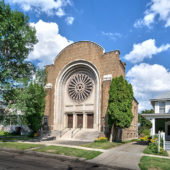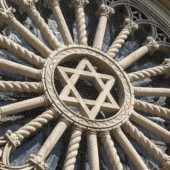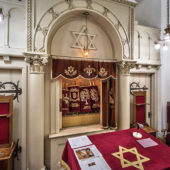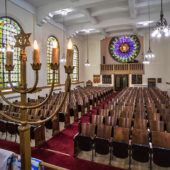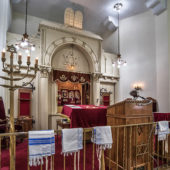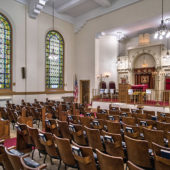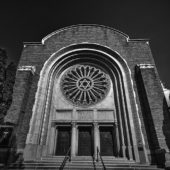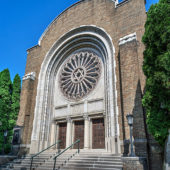A large and impressive synagogue in a small town.
For a town with population of little more than 14,000, and a small Jewish community, Olean has a big synagogue with seating for 350. In 1881 H.W. Marcus visited Olean while on his honeymoon. Born in Riga, Latvia and raised in Mobile, Alabama and Brooklyn, he decided to stay as the town was prospering from an oil boom. He immediately sought to establish a Jewish congregation although, according to some sources, there may have been only one other Jewish family in town. Marcus and other early Jewish residents persuaded family members and immigrants to settle in Olean.
Olean’s Jewish community was named the Young Men’s Hebrew Association in 1887. In 1894 the name was changed to Olean Hebrew Association and changed again in 1996 to Olean Hebrew Congregation. The congregation’s first ordained rabbi, Rabbi Elias Winer, joined the congregation about 1895 or 1896. Olean prospered and the Jewish population increased but plans for building a synagogue were put on hold until after World War I. In 1927 the congregation hired Olean architect J. Milton Hurd and construction company Havens & Coughlin to build a synagogue building. The local newspaper described the synagogue’s 1929 dedication as “age old ritualistic impressiveness, tempered with modern informality”.
The building is three and four stories tall. Hurd’s eclectic design combines a variety of eastern European and Middle Eastern styles. The front façade is dominated by a massive arch surrounding a huge and impressive Star of David stained glass window. Clearly, this design was influenced by other synagogues’ of the era such as New York City’s huge Temple Emanuel and Temple Beth-El in Brooklyn.
The architect, J. Milton Hurd, was born in nearby Wellsville and majored in architecture at Cornell University. He graduated as an honor student in 1916. After graduation Hurd served as sergeant with the American Expeditionary Forces in France during World War I, returning to Olean after the War. For most of his career he worked out of his Olean home, retiring in 1980 before passing away in 1892. In addition to projects in the Olean, during his long career he designed the Bradner Stadium in nearby Bradner and projects in Wellsville and Cuba. According to a student who interviewed Hurd, “Mr. Hurd, the architect, feels the synagogue was both an original and beautiful design. He is especially proud of the beautiful stained-glass window in front of the building which he helped design”.
The synagogue was listed on the National Register of Historic Places in 2012. As of 2015, the temple is still in regular use as a synagogue although the congregation is small.

